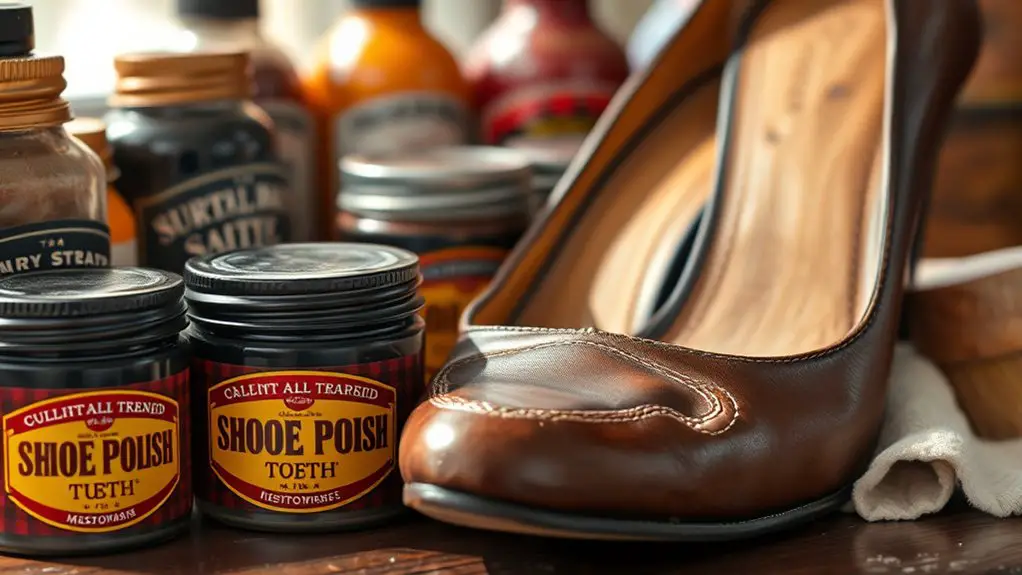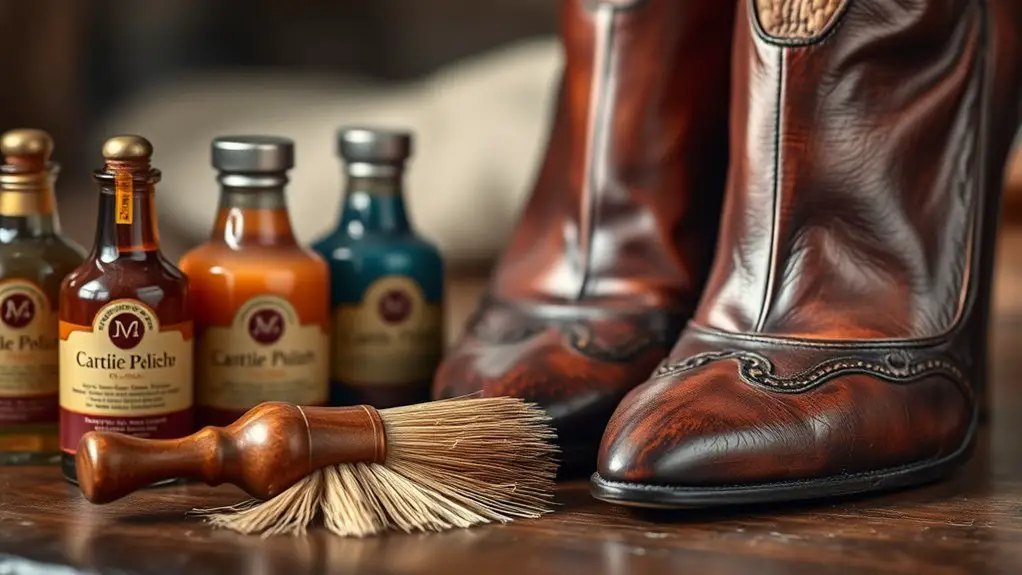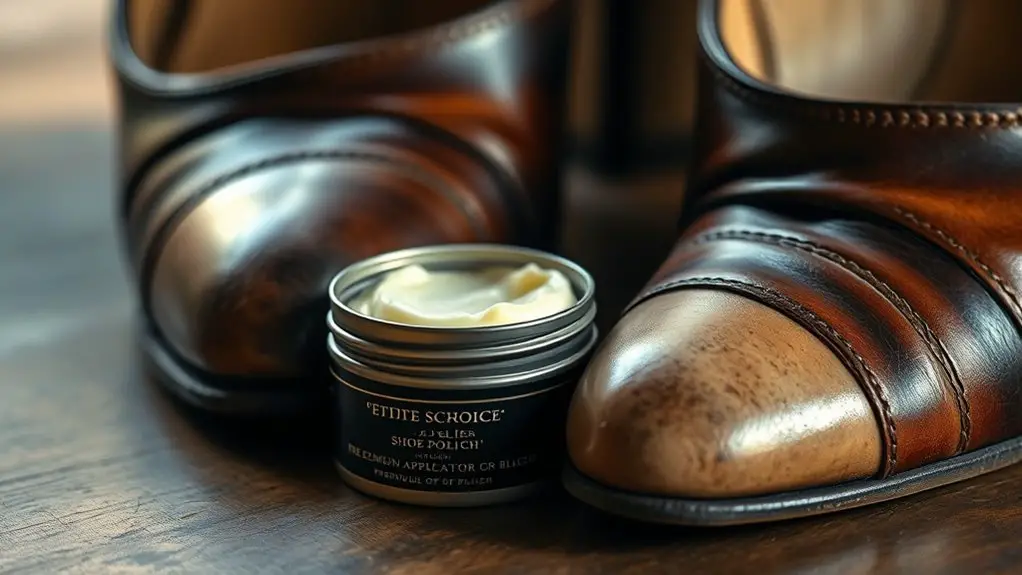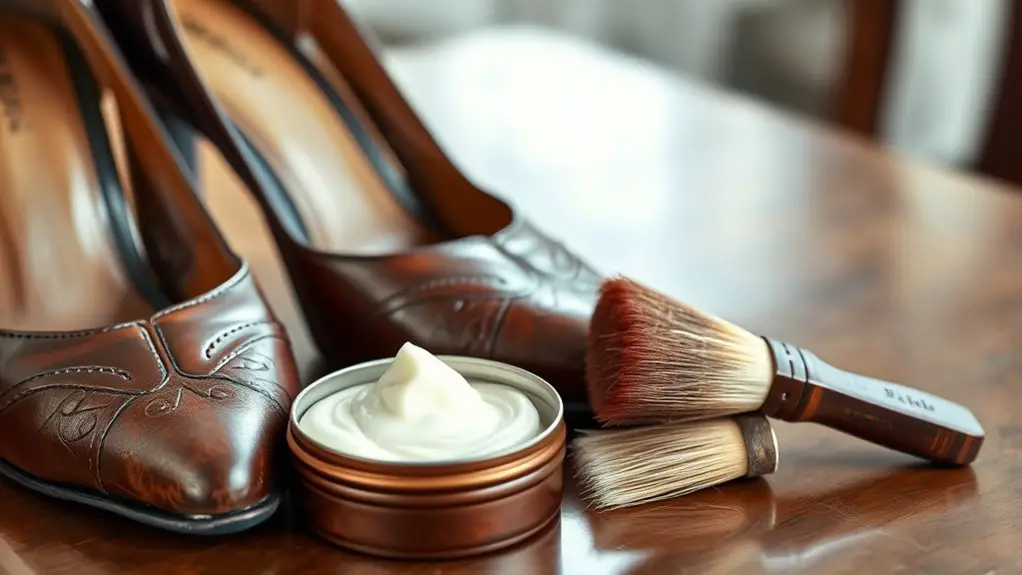For restoring old leather heels, consider using a cream polish like Bickmore Bick 4 which deeply conditions, or Kiwi Color Shine that revitalizes color. Wax polishes provide a brilliant shine and protection, while Angelus Leather Acrylic Paint is great for color revival. Always match the polish to your heel’s color and finish type. Applying it properly is key to achieving a flawless look. If you want tips on maintaining those heels, just keep going for more insights.
Understanding Different Types of Shoe Polish

When you’re choosing the right shoe polish for your leather heels, it’s important to understand the different types available, as each serves a unique purpose. There are generally three main types: cream, wax, and liquid polishes. Cream polishes nourish and hydrate the leather, thanks to their rich polish ingredients, while wax polishes provide a high shine and added protection, making them perfect for formal occasions. Liquid polishes are quick and convenient but may not offer the same depth of conditioning.
If you’re conscious about the environment, look for eco-friendly options that use natural ingredients, which can be just as effective without the harmful chemicals found in some traditional products. These alternatives not only care for your shoes but also contribute to a healthier planet. Understanding these differences can help you select the best polish for maintaining the beauty and longevity of your leather heels.
Top Shoe Polishes for Leather Restoration
Choosing the right shoe polish for leather restoration can make a world of difference in reviving your favorite pair of heels. When looking for top options, consider products from eco-friendly brands that prioritize sustainable options. One standout is the Kiwi Color Shine, known for its rich pigments and nourishing ingredients that restore leather while being environmentally conscious. Another great choice is the Angelus Leather Acrylic Paint, which not only revives color but also offers durability and protection against scuffs. For those seeking a more natural approach, try the Bickmore Bick 4 Leather Conditioner, which provides deep conditioning while being free from harmful chemicals. Finally, the Obenauf’s Leather Oil is perfect for enhancing water resistance and overall longevity. Each of these polishes is designed to rejuvenate your leather heels, ensuring they look fabulous for years to come while aligning with your eco-friendly values.
How to Choose the Right Shoe Polish for Your Heels

When choosing the right shoe polish for your heels, color matching is essential to guarantee a seamless look. You’ll also want to take into account the finish type, whether you prefer a matte or glossy appearance. Finally, think about the application method that suits your skill level and needs, as this can affect the overall results.
Color Matching Importance
Finding the right shoe polish for your leather heels is essential, as the wrong color can lead to unsightly mismatches that detract from their elegance. Start by evaluating the current shade of your heels; this will guide your color matching techniques. If the color has faded over time, consider color fading solutions that can restore vibrancy. Always test the polish on a small, inconspicuous area to guarantee an accurate match before applying it to the entire shoe. Remember, different brands may have slightly different shades, so comparing options can help you achieve a seamless look. By taking these steps, you’ll ensure your leather heels look polished and sophisticated, rather than worn and mismatched.
Finish Type Considerations
While it might seem straightforward, selecting the right finish type for your shoe polish can considerably impact the overall look and longevity of your leather heels. There are three primary finish types: matte finishes, glossy finishes, and satin finishes. Matte finishes provide a subtle, understated look, making them ideal for casual or vintage styles. If you prefer a polished, eye-catching appearance, glossy finishes are the way to go, enhancing colors and offering a vibrant shine. Satin finishes strike a balance between the two, offering a soft sheen that works well for both formal and casual occasions. Consider the look you want to achieve and the occasion when choosing your polish to guarantee your heels maintain their appeal and durability.
Application Method Tips
Choosing the right application method for your shoe polish can make all the difference in achieving a flawless finish on your leather heels. For a smooth and even coat, consider using a sponge application. This method allows you to evenly distribute the polish, minimizing streaks and ensuring full coverage. On the other hand, the brush technique is excellent for reaching intricate areas and providing a more polished look. Use a soft-bristled brush to gently buff the polish into the leather, enhancing its shine. Whichever method you choose, always start with a clean surface and apply the polish in thin layers. This approach not only protects your heels but also prolongs their life, keeping them looking their best.
Application Tips for a Flawless Finish

To achieve a flawless finish on your leather heels, start by preparing the surface properly. Clean off any dirt or old polish to guarantee the new application adheres well and looks smooth. Once you’re ready, apply even coats to avoid streaks and achieve that polished shine you’re aiming for.
Prepare the Surface
Preparing the surface of your leather heels is essential for achieving a flawless finish, and it only takes a few simple steps. Start with surface cleaning; use a soft cloth or brush to remove dirt and dust. Pay attention to crevices where grime can accumulate. Once clean, apply a leather conditioner to nourish the leather and restore its suppleness. This step not only enhances appearance but also helps the polish adhere better. Allow the conditioner to soak in for a few minutes before proceeding. By ensuring your leather is clean and conditioned, you’ll lay the groundwork for an even application of polish, ensuring your heels look refreshed and vibrant. Following these steps makes all the difference in the final result.
Apply Even Coats
With your leather heels cleaned and conditioned, you’re ready to apply polish for that polished look. The key to a flawless finish lies in your applying technique, guaranteeing even layering throughout the process. Start with a small amount of polish on your applicator, working it into the leather in circular motions. Build up layers gradually, allowing each coat to dry before applying the next. This prevents buildup and creates a smooth finish.
| Step | Action | Purpose |
|---|---|---|
| 1. Start Small | Use a dime-sized amount | Prevents excess polish |
| 2. Circular Motion | Apply in circles | Guarantees even coverage |
| 3. Wait to Dry | Allow each layer to dry | Promotes even layering |
Follow these steps, and you’ll achieve beautifully restored leather heels.
Maintaining Your Leather Heels After Polishing
Maintaining your leather heels after polishing is essential for preserving their beauty and longevity. First, guarantee you store your heels in a cool, dry place away from direct sunlight, which can cause fading and cracking. Use shoe trees to help retain their shape and absorb moisture. Regularly inspect your heels for scuffs or scratches and address them promptly with appropriate leather care products.
Consider applying a protective spray designed for leather to guard against water and stains. Clean your heels with a soft cloth to remove dirt and dust, as neglect can lead to buildup that damages the leather. For heel maintenance, be mindful of wear; replace heel caps as needed to prevent further damage. Finally, reapply polish every few months to maintain that fresh, polished look and keep the leather supple. By following these steps, your leather heels will remain stunning for years to come.
Homemade Shoe Polish Alternatives
If you’re looking for effective homemade shoe polish alternatives, you’ll find several simple recipes that can keep your leather heels looking fresh and well-cared for. One popular option is beeswax polish. To make it, combine equal parts of beeswax and coconut oil. Melt them together, let it cool slightly, then apply it to your shoes using a soft cloth. This mixture not only polishes but also provides a protective barrier against moisture.
Another alternative is a vinegar solution. Mix one part white vinegar with two parts olive oil. This mixture can help clean and condition your leather. Apply it with a cloth, rubbing it gently onto the surface. Afterward, buff with a clean cloth for a shiny finish. Both of these homemade options are eco-friendly and easy to prepare, ensuring your leather heels maintain their elegance without the use of commercial products.
Frequently Asked Questions
How Often Should I Polish My Leather Heels?
You should polish your leather heels every 3-4 weeks as part of your maintenance routine. Regular leather care not only enhances appearance but also protects against damage, ensuring longevity and keeping them looking their best.
Can Shoe Polish Fix Deep Scratches on Leather?
Imagine a knight’s armor, battered yet gleaming. Shoe polish can’t erase deep scratches entirely, but it works wonders for scratch repair and leather restoration, nourishing the leather and minimizing imperfections, making your heels shine like new.
Is It Safe to Use Polish on Suede Heels?
Using polish on suede heels isn’t recommended, as it can damage the material. Instead, focus on suede care techniques like brushing or using polish alternatives specifically designed for suede to maintain its texture and appearance.
What Is the Best Way to Store Shoe Polish?
For proper shoe polish storage, choose airtight containers to prevent drying out. Glass jars or plastic tubs work well. Keep them in a cool, dark place to maintain their effectiveness and extend their shelf life.
Can I Mix Different Brands of Shoe Polish?
Mixing different brands of shoe polish can lead to unpredictable results. While brand compatibility matters, combining polishes might diminish effectiveness. It’s best to stick to one brand for consistent color and finish on your leather.



